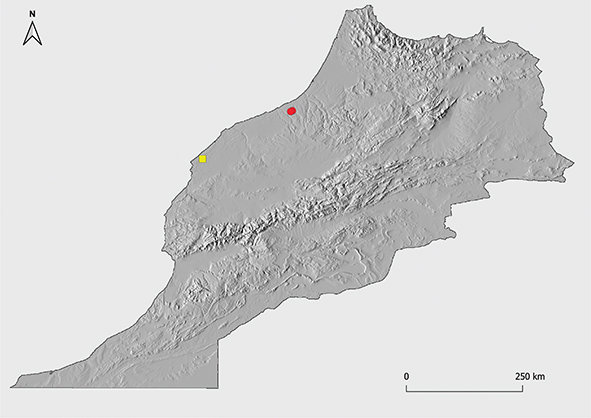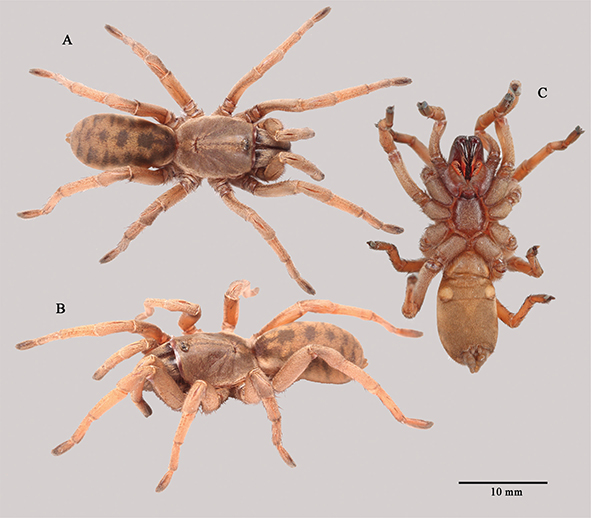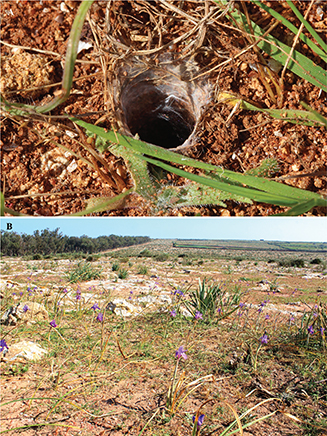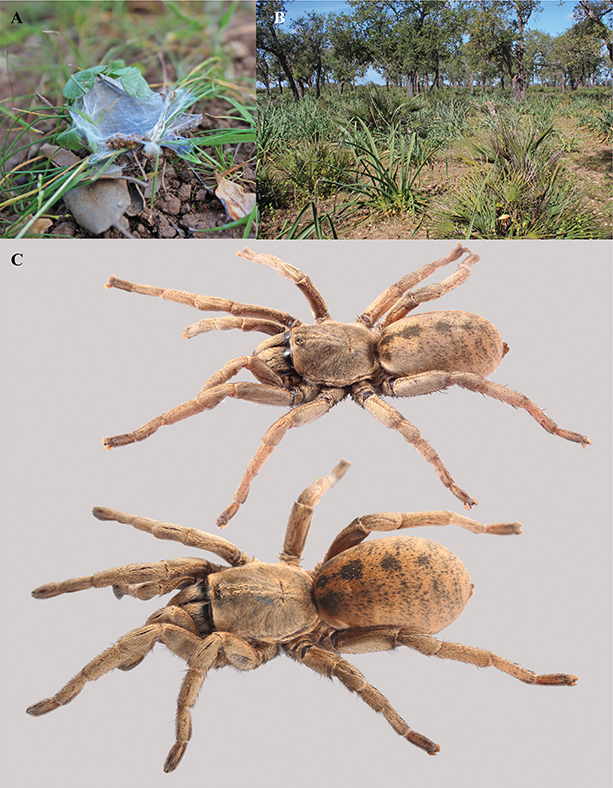Notas / Notes
Range extension of Harpactirella insidiosa (Denis, 1960) (Araneae: Mygalomorphae: Theraphosidae): a poorly known endemic spider from Morocco
Arnau Calatayud-Mascarell1 & Alberto Sánchez-Vialas1,*
1 Museo Nacional de Ciencias Naturales, MNCN-CSIC, c/José Gutiérrez Abascal, 2, 28006, Madrid, Spain.
ORCID iD: AC-M: http://orcid.org/0000-0003-0627-2616 — AS-V: http://orcid.org/0000-0003-0068-7669
*Corresponding author: alberto.alytes@gmail.com
| |
ABSTRACT
We provide a new record of the poorly studied theraphosid Harpactirella insidiosa (Denis, 1960) from Morocco, which was previously known only from its type locality in the surroundings of Ben Slimane. The new record, based on two adult females, extends the species distribution 210 km southwest from the type locality. These specimens were found at the Doukkala plain, 14 km southwest of Oualidia, and compared with topotypic specimens. In addition, we provide the first pictures of living specimens of the species and discuss its taxonomic status.
Keywords: Luphocemus; spiders; North Africa; Doukkala plain; new record; geographic distribution.
|
| |
RESUMEN
Ampliación del rango de distribución de Harpactirella insidiosa (Denis, 1960) (Araneae: Mygalomorphae: Theraphosidae): una araña endémica de Marruecos poco conocida.
En este trabajo presentamos una nueva cita de Harpactirella insidiosa (Denis, 1960), un terafósido escasamente estudiado de Marruecos, solamente conocido de la localidad tipo, situada en los alrededores de Ben Slimane. Este nuevo registro, basado en dos hembras adultas, amplía el área de distribución de la especie 210 km al suroeste de la localidad tipo. Ambos ejemplares fueron encontrados en la llanura de Doukkala, 14 km al sur de Oualidia, y comparados con topotipos de la especie. Esta nota se acompaña con las primeras imágenes de la especie in vivo y se discute, además, su situación taxonómica.
Palabras clave: Luphocemus; arañas; Norte de África; llanura de Doukkala; nuevo registro; distribución geográfica.
|
The spiders of the family Theraphosidae from Morocco are largely understudied and comprise two genera: Ischnocolus Ausserer, 1871 and Harpactirella Purcell, 1902. Guadanucci & Wendt (2014) and Zonstein (2018) conducted a taxonomic revision of Moroccan Ischnocolus species based on morphological data, and recorded the presence of three taxa: I. valentinus (Dufour, 1820), I. elongatus (Simon, 1873) and I. hancocki Smith, 1990. Whereas a considerable contribution to the taxonomy and biology of this genus in the Middle East has been recently published (see Montemor et al., 2019), basic aspects of the biology, natural history and geographic distribution of the Moroccan species of Ischnocolus remain almost unknown. Similarly, no studies concerning the only species of the genus Harpactirella from Morocco, Harpactirella insidiosa (Denis, 1960), have been published since its original description (Denis, 1960) and subsequent taxonomic reassessment (Benoit, 1965), being one of the least known species of Theraphosidae in the world.
The enigmatic spider and Moroccan endemic H. insidiosa was originally described in the monotypic genus Luphocemus Denis, 1960 [type species = Luphocemus insidiosus]. Denis (1960) described Luphocemus as follows: “Pièces buccales et chelicères des Leptopelma (= Ischnocolus sensu Denis, 1960); Hauteur de bandeau inférieure au double du grand axe des yeux latéraux antérieurs; Yeux postérieurs subégaux; Intervalle des yeux latéraux de chaque côté inférieur au diamètre des yeux latéraux postérieurs; Article terminal des filières supérieures plus long que l’article médian” [Mouthparts and chelicerae as in Leptopelma (= Ischnocolus sensu Denis, 1960); length of clypeus less than twice the distance between anterior-lateral eyes; sub-equal posterior eyes; distance between the lateral eyes of each side (anterior and posterior ones) less than the diameter of the posterior lateral eyes; distal segment of spinnerets larger than the medial segment]. Five years later, Benoit (1965) synonymized Luphocemus with Harpactirella, where it is currently allocated, based on some shared morphological traits between both taxa, namely a distal segment of spinnerets larger than the medial segment, and a similar morphology and relative position of the ocular tubercle and eyes.
Harpactirella insidiosa is only known from two female specimens collected at two localities from Northern Morocco in the surroundings of Ben Slimane: one at Boulhaut, collected on 30 December 1951, and the second one at Sokhrat Nemra, collected on 18 March 1955 (Denis, 1960). Males of H. insidiosa remain unknown.
In this article, we provide a new record based on the observation of two adult females of H. insidiosa far from their type locality. Both specimens were found in the Doukkala plain, 14 km southwest of Oualidia [approximate coordinates: 32°36’N, 09°0’W] (Fig. 1). The first one was observed under a rock on 29 December 2018 (Fig. 2), whereas the second recorded specimen was found within its burrow on 25 February 2020 (Fig. 3A). These findings extend the distribution of the species approximately 210 km southwest from the type locality. Measurements were taken from the first collected specimen, which had a total body length (carapace + abdomen) of approximately 20 mm, of which 9 mm correspond to the carapace (Fig. 1). Both specimens were compared with four topotypes collected from their burrows in Ben Slimane on 26 February 2020 (Fig. 4A–B). All examined individuals present the traits described for the types of the species (Denis, 1960). These topotypes exhibit similar colour patterns, except different brownish hues (Fig. 4C). The specimens from southern Oualidia slightly differ from the topotypes in the shape of the anterior-lateral eyes, which are more oval, and in their coloration, by showing a dorsal pattern of the opisthosoma with four distinctive oval dark marks, decreasing in size towards the posterior region, which are longitudinally arranged and bordered by additional transversal dark stripes. These marked transversal dark stripes on the abdominal sides are lacking in the topotype specimens which, in contrast, show a dotted abdominal pattern [Denis’ (1960) description only noted a brownish abdomen]. The ventral side of the abdomen is uniformly brown in the specimens from Oualidia (Fig. 2C). Burrows of both the Oualidia and topotype specimens were carefully excavated after checking for their entrances (Figs. 3A, 4A). The structure of the burrows consisted of a vertical or sub-vertical tunnel 15–25 cm deep, covered by silk, with a single small chamber at its end (pers.obs).
|
 Fig. 1.— Map of Morocco showing known localities for Harpactirella insidiosa. Red dots represent literature records (Denis, 1960). The yellow square corresponds to the new record at Doukkala plain. Fig. 1.— Map of Morocco showing known localities for Harpactirella insidiosa. Red dots represent literature records (Denis, 1960). The yellow square corresponds to the new record at Doukkala plain.
Fig. 1.— Mapa de Marruecos con las localidades conocidas de Harpactirella insidiosa. Los puntos rojos representan registros bibliográficos (Denis, 1960). El cuadrado amarillo corresponde al nuevo registro de la llanura de Doukkala.
|
|
|
 Fig. 2.— Adult female of Harpactirella insidiosa from Doukkala plain, Morocco. A: dorsal view; B: dorsolateral view; C: ventral view (Photographs AS-V). Fig. 2.— Adult female of Harpactirella insidiosa from Doukkala plain, Morocco. A: dorsal view; B: dorsolateral view; C: ventral view (Photographs AS-V).
Fig. 2.— Hembra adulta de Harpactirella insidiosa de la llanura de Doukkala, Marruecos. A: vista dorsal; B: vista dorsolateral; C: vista ventral (Fotografías AS-V).
|
|
|
 Fig. 3.— Burrow entrance (A) and habitat of Harpactirella insidiosa (B) in Doukkala plain, Morocco (Photographs AS-V). Fig. 3.— Burrow entrance (A) and habitat of Harpactirella insidiosa (B) in Doukkala plain, Morocco (Photographs AS-V).
Fig. 3.— Entrada de la madriguera (A) y hábitat de Harpactirella insidiosa (B) en Doukkala plain, Morocco (Fotografías AS-V).
|
|
|
 Fig. 4.— Burrow entrance of a topotype specimen (A). Surroundings of Ben Slimane, type locality of Harpactirella insidiosa (B). Two topotypes of Harpactirella insidiosa (C) (Fotografías AS-V). Fig. 4.— Burrow entrance of a topotype specimen (A). Surroundings of Ben Slimane, type locality of Harpactirella insidiosa (B). Two topotypes of Harpactirella insidiosa (C) (Fotografías AS-V).
Fig. 4.— Entrada de la madriguera de un ejemplar topotipo (A). Alrededores de Ben Slimane, localidad tipo de Harpactirella insidiosa (B). Dos topotipos de Harpactirella insidiosa (A) (Fotografías AS-V).
|
|
The Doukkala plain has a semiarid climate (Escoriza & Ben-Hassine, 2019) and is mostly composed by limestone (Fakir et al., 2002) with grasslands dominated by Asphodelus L. and scrubs of Chamaerops humilis L. and Olea europaea L., among others (Fig. 3B). The natural areas of the region are negatively impacted by agricultural development, Eucalyptus plantations, and urbanization in littoral areas (Hinckley et al., 2016). Unfortunately, the lack of any biological information, including the ecological requirements of H. insidiosa, difficult the identification of potential threats that the species may be facing, preventing the proposal of specific conservation actions.
The finding of the presence of H. insidiosa in a semiarid climate, distinct from the warm Mediterranean climate predominant on the previously known localities, suggests that this species may be more broadly distributed that previously considered. However, molecular studies should be undertaken to confirm that the newly found population is conspecific with the northern populations of H. insidiosa. It should be borne in mind, however, that molecular studies in other mygalomorph taxa have revealed deep genetic divergences within single morphologically delimited species, usually corresponding to geographically restricted populations (Arnedo & Ferrández, 2007; Hamilton et al., 2011; Harvey et al., 2015; Ferretti et al., 2019). These studies suggest that the current diversity of mygalomorph spiders may have been grossly underestimated. Further integrative studies combining molecular and morphological, but also ecological and behavioural data may shed new light into the taxonomic status of the Doukkala population of H. insidiosa.
Molecular data may also contribute to resolve another important question posed by Moroccan Harpactirella. Except for the Moroccan H. insidiosa, the genus Harpactirella is exclusively composed of Afrotropical species, all of them endemic from South Africa, namely H. treleaveni Purcell, 1902, H. karroika Purcell, 1902, H. lightfooti Purcell, 1902, H. longipes Purcell, 1902, H. magna Purcell, 1903, H. helenae Purcell, 1903, H. domicola Purcell, 1903, H. schwarzi Purcell, 1904, H. lapidaria Purcell, 1908, H. spinosa Purcell, 1908, and H. overdijki Gallon, 2010 (World Spider Catalog, 2020). If Benoit’s (1965) inclusion of the Moroccan species in Harpactirella holds true, the resulting disjunct distribution showed by this genus represents an interesting biogeographic pattern that merits further investigation. Nevertheless, because of the rampant homoplasy of the few variable traits in an otherwise highly conserved phenotype (Raven, 1985; Bond & Opel, 2002; Hamilton et al., 2011), mygalomorph taxonomy has proven to be a challenging task (Hendrixson et al., 2013; Harvey et al., 2015; Ferretti et al., 2019). The scrutiny of traditional taxonomic groups with new molecular information has revolutionized our understanding of the classification of mygalomorph spiders (e.g. Opatova et al., 2019). In this regard, the synonymy of Luphocemus and Harpactirella, which was mostly based on two main morphological traits, may not resist a more detailed, molecular based re-examination.
The aforementioned observations highlight (1) the necessity of improving the taxonomic information on H. insidiosa, both at intra- and supra-specific levels, (2) the importance of compiling notes on its natural history, through carefully planned field work across the known localities and ecologically similar regions, (3) and the urgent need for measures to ensure conservation of this rare and poorly known species, inhabiting a vulnerable and highly disturbed region, outside natural protected areas.
AcknowledgementsTOP
We are deeply grateful to Miguel Arnedo whose suggestions greatly improved the manuscript and to Miguel Angel Ferrández for useful comments. We thank Javier Aznar González de Rueda for his help during fieldwork campaigns in Morocco between 2012 and 2019. Fieldwork was carried out with permits from the Haut Commissaire aux Eaux et Forêts et à la Lutte Contre la Désertification (HCEFLCD /DLCDPN /DPRN/CFF Nº19/2018).
ReferencesTOP
| ○ |
Arnedo, M. A. & Ferrández, M. A. 2007. Mitochondrial markers reveal deep population subdivision in the European protected spider Macrothele calpeiana (Walckenaer, 1805) (Araneae, Hexathelidae). Conservation Genetics, 8: 1147–1162. https://doi.org/10.1007/s10592-006-9270-2 |
| ○ |
Benoit, P. L. G., 1965. Études sur les Barychelidae du Centre Africain (Araneae-Orthognatha) II. - Leptopelmatinae nouveaux. Revue de Zoologie et de Botanique Africaines, 71: 297–303. |
| ○ |
Bond, J. E. & Opell, B. D., 2002. Phylogeny and taxonomy of the genera of south-western North American Euctenizinae trapdoor spiders and their relatives (Araneae: Mygalomorphae, Cyrtaucheniidae). Zoological Journal of the Linnean Society, 136(3): 487–534. https://doi.org/10.1046/j.1096-3642.2002.00035.x |
| ○ |
Denis, J., 1960. Notes d’aranéologie marocaine. VIII. Un barychélide nouveau du Maroc. Bulletin de la Société des Sciences Naturelles du Maroc, 39: 185–189. |
| ○ |
Escoriza, D. & Ben Hassine, J., 2019. Amphibians of North Africa. Academic Press. London. 350 pp. |
| ○ |
Fakir, Y., El Mernissi, M., Kreuser, T. & Berjami, B., 2002. Natural tracer approach to characterize groundwater in the coastal Sahel of Oualidia (Morocco). Environmental Geology, 43(1-2): 197–202. https://doi.org/10.1007/s00254-002-0644-6 |
| ○ |
Ferretti, N. E., Soresi, D. S., González, A. & Arnedo, M., 2019. An integrative approach unveils speciation within the threatened spider Calathotarsus simoni (Araneae: Mygalomorphae: Migidae). Systematics and Biodiversity, 17(5): 439–457. https://doi.org/10.1080/14772000.2019.1643423 |
| ○ |
Guadanucci, J. P. L., & Wendt, I., 2014. Revision of the spider genus Ischnocolus Ausserer, 1871 (Mygalomorphae: Theraphosidae: Ischnocolinae). Journal of Natural History, 48(7-8): 387–402. https://doi.org/10.1080/00222933.2013.809492 |
| ○ |
Hamilton, C. A., Formanowicz, D. R. & Bond, J. E., 2011. Species delimitation and phylogeography of Aphonopelma hentzi (Araneae, Mygalomorphae, Theraphosidae): cryptic diversity in North American tarantulas. PloS ONE, 6(10): e26207. https://doi.org/10.1371/journal.pone.0026207 |
| ○ |
Harvey, M. S., Main, B. Y., Rix, M. G. & Cooper, S. J., 2015. Refugia within refugia: in situ speciation and conservation of threatened Bertmainius (Araneae: Migidae), a new genus of relictual trapdoor spiders endemic to the mesic zone of south-western Australia. Invertebrate Systematics, 29(6): 511–553. https://doi.org/10.1071/IS15024 |
| ○ |
Hendrixson, B. E., Derussy, B. M., Hamilton, C. A. & Bond, J. E., 2013. An exploration of species boundaries in turret-building tarantulas of the Mojave Desert (Araneae, Mygalomorphae, Theraphosidae, Aphonopelma). Molecular Phylogenetics and Evolution, 66(1): 327–340. https://doi.org/10.1016/j.ympev.2012.10.004 |
| ○ |
Hinckley, A., Sánchez-Vialas, A., Talavera, A. & Slimani, T., 2016. Update on the ecology and conservation of the endangered and umbrella species: Pelobates varaldii. Boletín de la Asociación Herpetológica Española, 27(1): 112–118. |
| ○ |
Montemor, V. M., West, R. C., Zamani, A., Moradmand, M., Wirth, V. V., Wendt, I., Huber, S. & Guadanucci, J. P. L., 2019. Taxonomy of the genus Ischnocolus in the Middle East, with description of a new species from Oman and Iran (Araneae: Theraphosidae). Zoology in the Middle East, 66(1): 76–90. https://doi.org/10.1080/09397140.2020.1675994 |
| ○ |
Opatova, V., Hamilton, C. A., Hedin, M., De Oca, L. M., Kral, J. & Bond, J. E., 2019. Phylogenetic systematics and evolution of the spider infraorder Mygalomorphae using genomic scale data. BioRxiv, 531756. https://doi.org/10.1101/531756 |
| ○ |
Raven, R. J., 1985. The spider infraorder Mygalomorphae (Araneae): Cladistics and systematics. Bulletin of the American Museum of Natural History, 182(1): 1–180. Available from http://digitallibrary.amnh.org/handle/2246/955 [accessed 9 Sep. 2020]. |
| ○ |
World Spider Catalog 2020: World Spider Catalog. Version 21.0. Natural History Museum. Bern. Available from http://wsc.nmbe.ch [accessed 7 Jul. 2020]. |
| ○ |
Zonstein, S. L., 2018. Complementary data on the genus Ischnocolus (Araneae: Theraphosidae). Israel Journal of Entomology, 48: 105–118. |
Fig. 1.— Map of Morocco showing known localities for Harpactirella insidiosa. Red dots represent literature records (Denis, 1960). The yellow square corresponds to the new record at Doukkala plain.